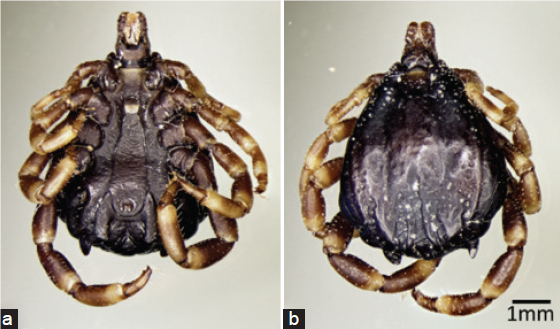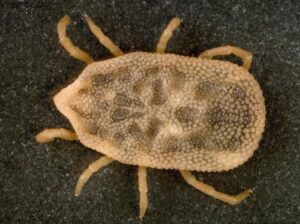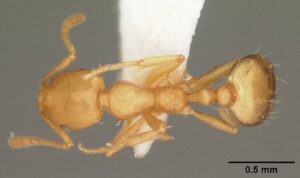Camel Tick:
General Description
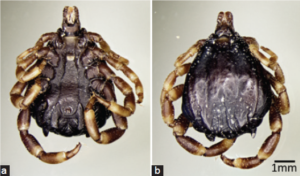
Camel tick Hyalomma dromedarii (Acari: Ixodidae) adult male:
(a) Ventral and (b) dorsal (Credit: Al-Deeb and Bin Muzaffar, Veterinarywork.org)
- The dorsal shield of males can reach a length of 3.7–5.8 mm.
- These hard-bodied ticks are broadly oval in shape.
- The basic color is yellow- to red-brown.
Life Cycle and Common Characteristics
- The camel tick parasitizes mainly camels (that are the main hosts of the adults) but may infect cattle, horses, sheep, goats, dogs, rodents, birds, or humans.
- The fertilized blood-drinking females lay eggs in the cracks of the walls or under the stones in the places where animals are raised.
- One female can lay from 2000-14000 eggs at once, and then it dies.
- The eggs hatch after 15-60 days.
- The camel tick is a two-host tick. The incomplete stages live on the same host, then the blood-sipping nymphs fall off to molt in the soil, then the adult re-attaches to the same host or any other host.
- The larvae that climb grasses or walls, and remain as well, waiting for the body of their preferred host to touch those grasses or walls (it prefers small mammals such as rodents and lizards), attach to it and suck its blood. It molts twice on the same host in a period of 4-8 days, then leaves the host to hide again in the cracks and under the stones, where it molts into a full animal after 15-45 days to re-attach to the preferred host for the full phase (the tick prefers large mammals such as camels, cattle and sheep and may infect humans). It feeds on its blood for a period of 10-15 days, and after being fertilized the female leaves the host to lay eggs.
Damage and Medical Implications
- Camel ticks are blood feeding parasites in all their life stages after the egg and in both sexes (images show infestation of camel ticks on different body parts of the camel)
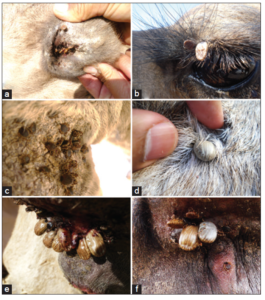
Camel ticks on different body parts of the camel: (a) Ear, (b) upper eyelid, (c) leg, (d) abdomen, and (e and f) tail area (Credit: Al-Deeb and Bin Muzaffar, veterinaryworld.org)
- They are vectors of bacterial, protozoal, rickettsial, spirochaetal, and viral diseases of humans and animals.
- Irritating bites of camel ticks cause severe harm to their hosts due to blood loss, damage to the skin, and anorexia that lead to reduction in Lesions and secondary infections are commonly caused by bites of these ticks.
- Camel ticks are the major vector of theCrimean-Congo hemorrhagic fever virus (CCHFV). The transmission cycles involve different livestock.
- Nymphs feed on birds and small burrowing animals as rodents, but the nymphs can infest large animalslike It commonly behaves as a two-host tick and appears throughout the year. It is found wherever camels live. It has a vital role in the transmission of emerging and re-emerging diseases such as Theileria, Rickettsia, Francisella, Q fever, and other viruses.
II – Soft Ticks Soft ticks differ from hard ticks in the absence of a hard chitinous shield, in addition to the fact that the mouth parts are located on the lower surface of the body and are not seen from above, unlike hard ticks. Males and females are similar in appearance, and when they drink in adult animals, they do not noticeably increase in size. Four genera belong to soft ticks, the most important of which from a health point of view for humans are the genus Orinthodoros which causes the relapsing fever tick, and the genus Argas which causes common fowl tick. Both genera infect humans asymptomatically in the absence of their preferred host. The life cycle differs from that of the hard ticks in the feeding period of different instars and the number of feeding times. The larvae feed for up to 10 days, while the feeding period for nymphs and adults does not exceed half an hour each time. The female feeds several times and lays a few eggs after each time.

